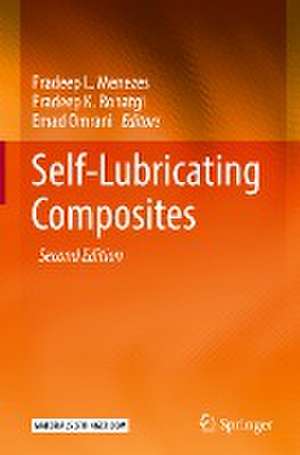Self-Lubricating Composites
Editat de Pradeep L. Menezes, Pradeep K. Rohatgi, Emad Omranien Limba Engleză Hardback – 4 ian 2022
| Toate formatele și edițiile | Preț | Express |
|---|---|---|
| Paperback (2) | 626.10 lei 38-44 zile | |
| Springer Berlin, Heidelberg – 5 ian 2023 | 626.10 lei 38-44 zile | |
| Springer Berlin, Heidelberg – 10 ian 2019 | 824.22 lei 38-44 zile | |
| Hardback (1) | 1115.46 lei 3-5 săpt. | |
| Springer Berlin, Heidelberg – 4 ian 2022 | 1115.46 lei 3-5 săpt. |
Preț: 1115.46 lei
Preț vechi: 1360.32 lei
-18% Nou
Puncte Express: 1673
Preț estimativ în valută:
213.45€ • 223.42$ • 177.65£
213.45€ • 223.42$ • 177.65£
Carte disponibilă
Livrare economică 10-24 martie
Preluare comenzi: 021 569.72.76
Specificații
ISBN-13: 9783662642429
ISBN-10: 3662642425
Pagini: 296
Ilustrații: XV, 296 p. 188 illus., 98 illus. in color.
Dimensiuni: 155 x 235 mm
Greutate: 0.64 kg
Ediția:2nd ed. 2022
Editura: Springer Berlin, Heidelberg
Colecția Springer
Locul publicării:Berlin, Heidelberg, Germany
ISBN-10: 3662642425
Pagini: 296
Ilustrații: XV, 296 p. 188 illus., 98 illus. in color.
Dimensiuni: 155 x 235 mm
Greutate: 0.64 kg
Ediția:2nd ed. 2022
Editura: Springer Berlin, Heidelberg
Colecția Springer
Locul publicării:Berlin, Heidelberg, Germany
Cuprins
Solid Lubricants: Classification, Properties and Applications.- Tribology of Self-Lubricating Metal Matrix Composites.- In Situ Generated Turbostratic 2D Graphite: A New Way to Obtain High-Performance Self-Lubricating Iron-Based Composites.- Self-Lubricating Polymer Composites: Mechanisms, Properties and Applications.- Tribology of Self-Lubricating Polymer Nanocomposites.- Polymeric Solid Lubricant Transfer Films: Relating Quality to Wear Performance.- Self-lubricating Ceramic Matrix Composites.- Recent Progress in Self-Lubricating Ceramic Composites.- Surface Engineering Design of Alumina-Matrix Composites.- Environmental Analysis of Self-Lubricating Composites: A Review.- Molecular Dynamics Simulation of Friction in Self-Lubricating Materials: An Overview of Theories and Available Models.
Notă biografică
Pradeep L. Menezes (corresponding author) is an associate professor in the Department of Mechanical Engineering at the University of Nevada, Reno, Nevada. Before joining this university, he worked as an adjunct assistant professor at the University of Wisconsin–Milwaukee (UWM), Wisconsin, and as a research assistant professor at the University of Pittsburgh, Pennsylvania. Dr. Menezes’s productive research career has produced more than 120 peer-reviewed journal publications (citations more than 5000, h-index–34), 30 book chapters, and 4 books related to tribology.
Pradeep K. Rohatgi is a UWM Distinguished Professor. He has coedited and coauthored 12 books and more than 400 scientific papers and has 19 US patents. He is considered as a world leader in composites and materials policy for the developing world. He has served on committees of the governments of the USA and India in the areas of materials, especially those related to automotive sector, to promote collaboration. His research includes advanced manufacture of lightweight, energy-absorbing, self-lubricating, and self-healing materials and components, including micro- and nano-composites and syntactic foams. He is the founder chief technology officer (CTO) of Intelligent Composites, LLC, Milwaukee, Wisconsin.
Emad Omrani is a process engineer at Intel Corporation. He was a graduate student of Dr. Rohatgi at the UWM. He has coauthored 2 book chapters and over 10 peer-reviewed scientific papers. At UWM, Dr. Menezes collaborated with Dr. Rohatgi and Dr. Omrani in the areas of tribology and self-lubricating materials and published several research papers on the tribology of self-lubricating materials. Dr. Menezes and Dr. Rohatgi are well-known tribologists and self-lubricating materials scientists. These editors are therefore well known and well connected in this field to put forth an excellent book on this topic.
Pradeep K. Rohatgi is a UWM Distinguished Professor. He has coedited and coauthored 12 books and more than 400 scientific papers and has 19 US patents. He is considered as a world leader in composites and materials policy for the developing world. He has served on committees of the governments of the USA and India in the areas of materials, especially those related to automotive sector, to promote collaboration. His research includes advanced manufacture of lightweight, energy-absorbing, self-lubricating, and self-healing materials and components, including micro- and nano-composites and syntactic foams. He is the founder chief technology officer (CTO) of Intelligent Composites, LLC, Milwaukee, Wisconsin.
Emad Omrani is a process engineer at Intel Corporation. He was a graduate student of Dr. Rohatgi at the UWM. He has coauthored 2 book chapters and over 10 peer-reviewed scientific papers. At UWM, Dr. Menezes collaborated with Dr. Rohatgi and Dr. Omrani in the areas of tribology and self-lubricating materials and published several research papers on the tribology of self-lubricating materials. Dr. Menezes and Dr. Rohatgi are well-known tribologists and self-lubricating materials scientists. These editors are therefore well known and well connected in this field to put forth an excellent book on this topic.
Caracteristici
No comprehensive literature on self-lubricating materials An awareness for industries to employ self-lubricating materials Environmentally friend materials (green materials)
